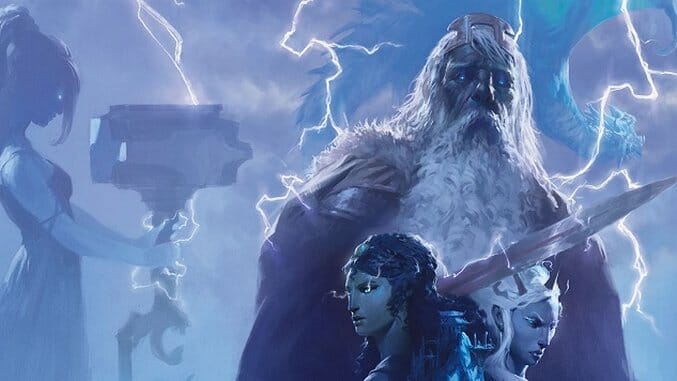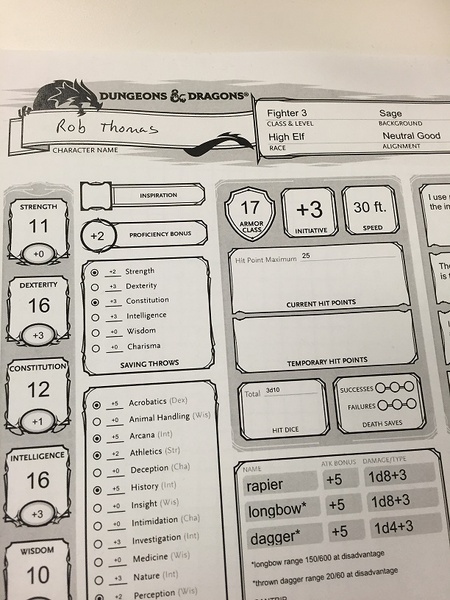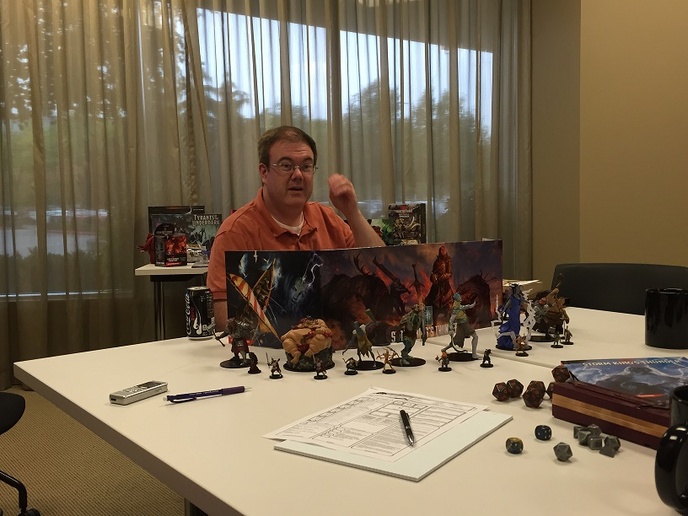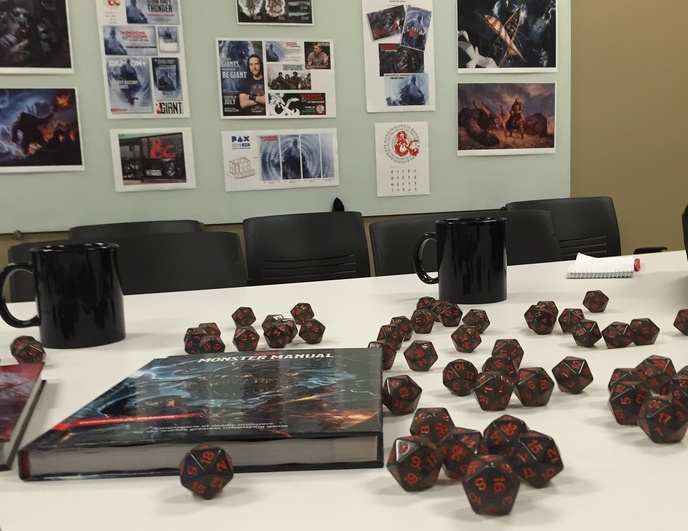
Rob Thomas used his ability to see in the dark to guide Clarko Santana as they scrambled down a tight cave passageway. They’d encountered goblins (killed by the party), negotiated with some trolls (wounded and then recruited by the party), and found a sinkhole filled with human prisoners (status uncertain). They’d been traveling for years pursuing Clarko Santana’s dream of fame. On the cusp of greatness, the two banded together with a motley crew of adventurers to accomplish their mission. The tunnel became a cave, a goblin king was killed, and the refugees were saved. It was a hot one.
I, of course, was Rob Thomas. Santana was played by former Paste-r Rollin Bishop. Our life-long connection was forged in the moment, a synthetic creation of Rollin’s naming practice and my eternal desire to make jokes about Matchbox Twenty. It was organic and off-the-cuff, and although we were playing through a small section of content from the new Storm King’s Thunder adventure, we were able to put our very particular mark on this play session composed of random journalists who hadn’t met before that day.
My grandfather used to take me to car shows when I was a kid. I know that there are huge shows where people bring their classic cars and where companies show off their newest speculative offerings, but these events were not those. They were small-town car shows where enthusiasts brought their Camaros from the mid-1980s so that they could park them across from each other and holler over the sound of competitive revving. There was always a cake walk at the end.
What I remember about those events was the dedication of the organizers and participants. These were people who spent all of their time thinking about and working on cars. They just wanted to get together to share that. They wanted to work and think together because that made it so much better. They wanted to build something.
Spending time in the Dungeons & Dragons offices gave me whiplash deja vu back to those events. I wandered around the sometimes-dimmed offices, weaving between statues and cubicles, and I tried to get a handle on the game now and in the future. I saw parts of Volo’s Guide to Monsters. I looked at a wall of concepts, characters and art from Storm King. I saw a very neat and gigantic digital representation of Tiamat. It was a comprehensive experience that I can only describe as totalizing. It was like dunking your head in cold water or listening to AC/DC’s greatest hits pumped from a giant speaker system that someone’s cousin brought to a backyard party. It’s all immersion all the time.
That’s not the car show feeling, though. That’s just crafting an experience, and I enjoyed that wandering tour for the beautiful creation that it was.
The true dedication from the Dungeons & Dragons team, that car show feel of enthusiasts coming together to work on whatever they want, was present across the aisle from the 3D model of Tiamat. I couldn’t help staring over the shoulder of an artist doing something else entirely. He was working on some small part of a model, and he kept tabbing back to a Google search of the word phrase “moon planet.” I wanted to laugh (I mean, say it out loud to yourself), but I watched him tab back and forth between his modeling program and the Google image search. He’d tweak it. He’d look at images of moons. He’d tweak. He’d view the moons. Back and forth. He wasn’t finished when we left.
I found that little movement inspirational. This was the kind of care you’d find from someone replacing a spark plug. It was fine, detailed work that he thought was worth getting right, and this was an intensive moment of trying to dial in the texture or “moon feel” that he needed to get.
Later that day Richard Whitters told me that Dungeons & Dragons is a “fiddler’s game.” He meant that it was a game for people who want to create. For Whitters, that was doing something like redesigning the classic D&D demonic lords for a new audience in Out Of The Abyss. It was about dialing it in and getting things right. Making sure that the demonic lord Jubilex “feels” right is about intensive thinking, and when Whitters told me that I thought back to that moon planet artist. He was fiddling, or dialing the specifics in, the same way that the rest of the team working on larger story, art or marketing concepts were.
Creative specificity ran through my entire day in the D&D facilities. I’ll admit to being more curious about how people play the game than I am about what they’re releasing for the game at any given moment, and the questions I asked people like story director Chris Perkins and head of development Mike Mearls were all about the ways they play the game rather than about how they’ve designed things for us to experience at home.
Perkins described to me his totalized dedication to the game as a teenager, submitting adventure designs to Dungeon magazine until they eventually accepted his “The Wards of Witching Ways.” Mearls told me about his homebrew campaign that puts the mortal adventurers in a conflict between angels, devils and fae where there are only bad choices and everyone but the power players are collateral damage. Whitters explained that he was once running forty different players in several games that were all located in the same city, each group impacting the others across a long timeline.
Every story I heard from someone at Dungeons & Dragons revolved around taking the game, focusing in on some concept or idea, and then being as creative as possible with it. They’re plinking away at an engine, admiring the belts or the fuel pumps or the stereo systems, and they’re all interested in sharing it with other people.
Unlike hobbyist mechanics, the D&D team share their creations with the entire world. They do this strange, intensive creation, and at the end there are sourcebooks and adventures and handbooks that the entire world looks to for both inspiration and content for their games at home.
Dungeons & Dragons strikes a balance. From the inside, it feels so small and personal to these people who have been thinking about the game and playing it for thirty years or more. Batch-made picnic baskets or beautifully-tuned classic cars pale in comparison to ten minutes of hearing Chris Perkins talking about the evolution of his design thinking when it comes to role-playing game stories. From the outside, it’s a massive brand distributed across the world, dominating the market of roleplaying games and the imaginations of players everywhere. People who’ve never thought to pick up a character sheet have committed to the game because of name recognition and listening to some celebrities on a podcast. It’s a gravity well that drives people toward its systems and the narratives that they can create.
It hasn’t always seemed that way. Dungeons & Dragons’s history is plagued with barriers that prevented it from being accessible (if you don’t believe me, go calculate THAC0). There were mechanical and narrative tropes that made it a walled garden even if the wall was ornate and the garden was exquisite. Dungeons & Dragons in the Fall of 2016 is maybe as trendy and accessible as it has ever been. The most brutal complexity has been weaned out of the game in favor of storytelling and creativity, and I don’t think it is any coincidence that now everyone I know wants to be in a game of D&D.
There’s something comforting about knowing that the development end is filled with people who just want to create tools to help you make fantastical stories about giants or fill a medieval village full or dogs or to recreate your favorite fantasy series in exacting detail.
When I held Santana’s hand, I was fully bought into D&D. At that moment, I was living in the fantasy, caught up in just enough rules to make sense but not enough to override the experience. Somewhere in the mixture of game design, improvisation, and iteration, the development team of the game has hit a mixture that has enabled anyone who’ll roll up a character to dive deep into their systems to create their own narratives about their own special worlds.
Like the enthusiasts at the car shows, the team at Dungeons & Dragons are focused on the things that make their lives meaningful. They’re working on something that will surely outlast them in the same way that the Camaro owner hopes those sweet 1980s bumpers will outlast her.
Unlike the car owner, the D&D team is building something for the world to take over and make its own. The seeds they plant in the rulebooks and adventures bloom in the homes of their players. Some mutate beyond control, and some grow just like you’d think they would. Some produce fruit like a joke that revolves around the song “Smooth.” Every single one is memorable.
Cameron Kunzelman tweets at @ckunzelman and writes about games at thiscageisworms.com. His latest game, Epanalepsis, was released last year. It’s available on Steam.


